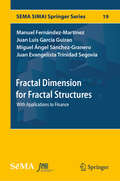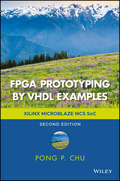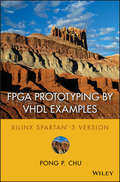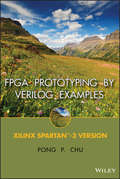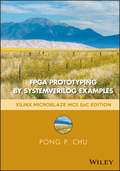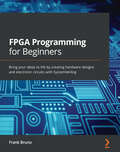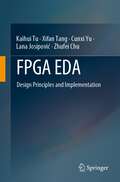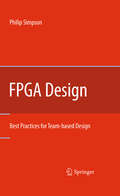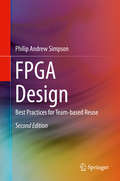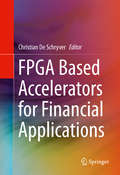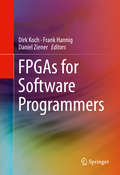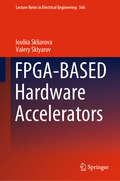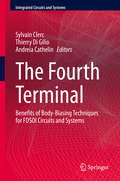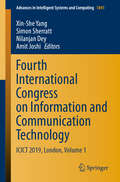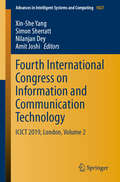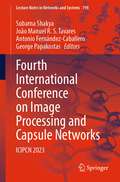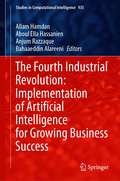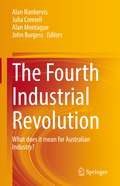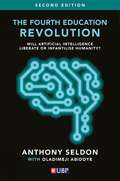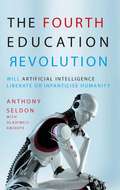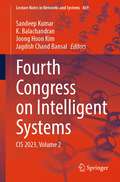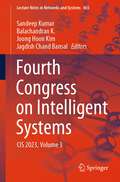- Table View
- List View
Fractal Dimension for Fractal Structures: With Applications to Finance (SEMA SIMAI Springer Series #19)
by Manuel Fernández-Martínez Juan Luis García Guirao Miguel Ángel Sánchez-Granero Juan Evangelista Trinidad SegoviaThis book provides a generalised approach to fractal dimension theory from the standpoint of asymmetric topology by employing the concept of a fractal structure. The fractal dimension is the main invariant of a fractal set, and provides useful information regarding the irregularities it presents when examined at a suitable level of detail. New theoretical models for calculating the fractal dimension of any subset with respect to a fractal structure are posed to generalise both the Hausdorff and box-counting dimensions. Some specific results for self-similar sets are also proved. Unlike classical fractal dimensions, these new models can be used with empirical applications of fractal dimension including non-Euclidean contexts. In addition, the book applies these fractal dimensions to explore long-memory in financial markets. In particular, novel results linking both fractal dimension and the Hurst exponent are provided. As such, the book provides a number of algorithms for properly calculating the self-similarity exponent of a wide range of processes, including (fractional) Brownian motion and Lévy stable processes. The algorithms also make it possible to analyse long-memory in real stocks and international indexes.This book is addressed to those researchers interested in fractal geometry, self-similarity patterns, and computational applications involving fractal dimension and Hurst exponent.
FPGA Prototyping by VHDL Examples: Xilinx Microblaze Mcs Soc
by Pong P. ChuA hands-on introduction to FPGA prototyping and SoC design This Second Edition of the popular book follows the same “learning-by-doing” approach to teach the fundamentals and practices of VHDL synthesis and FPGA prototyping. It uses a coherent series of examples to demonstrate the process to develop sophisticated digital circuits and IP (intellectual property) cores, integrate them into an SoC (system on a chip) framework, realize the system on an FPGA prototyping board, and verify the hardware and software operation. The examples start with simple gate-level circuits, progress gradually through the RT (register transfer) level modules, and lead to a functional embedded system with custom I/O peripherals and hardware accelerators. Although it is an introductory text, the examples are developed in a rigorous manner, and the derivations follow strict design guidelines and coding practices used for large, complex digital systems. The new edition is completely updated. It presents the hardware design in the SoC context and introduces the hardware-software co-design concept. Instead of treating examples as isolated entities, the book integrates them into a single coherent SoC platform that allows readers to explore both hardware and software “programmability” and develop complex and interesting embedded system projects. The revised edition: Adds four general-purpose IP cores, which are multi-channel PWM (pulse width modulation) controller, I2C controller, SPI controller, and XADC (Xilinx analog-to-digital converter) controller. Introduces a music synthesizer constructed with a DDFS (direct digital frequency synthesis) module and an ADSR (attack-decay-sustain-release) envelop generator. Expands the original video controller into a complete stream-based video subsystem that incorporates a video synchronization circuit, a test pattern generator, an OSD (on-screen display) controller, a sprite generator, and a frame buffer. Introduces basic concepts of software-hardware co-design with Xilinx MicroBlaze MCS soft-core processor. Provides an overview of bus interconnect and interface circuit. Introduces basic embedded system software development. Suggests additional modules and peripherals for interesting and challenging projects. The FPGA Prototyping by VHDL Examples, Second Edition makes a natural companion text for introductory and advanced digital design courses and embedded system course. It also serves as an ideal self-teaching guide for practicing engineers who wish to learn more about this emerging area of interest.
FPGA Prototyping by VHDL Examples
by Pong P. ChuThis book uses a "learn by doing" approach to introduce the concepts and techniques of VHDL and FPGA to designers through a series of hands-on experiments. FPGA Prototyping by VHDL Examples provides a collection of clear, easy-to-follow templates for quick code development; a large number of practical examples to illustrate and reinforce the concepts and design techniques; realistic projects that can be implemented and tested on a Xilinx prototyping board; and a thorough exploration of the Xilinx PicoBlaze soft-core microcontroller.
FPGA Prototyping By Verilog Examples
by Pong P. ChuFPGA Prototyping Using Verilog Examples will provide you with a hands-on introduction to Verilog synthesis and FPGA programming through a "learn by doing" approach. By following the clear, easy-to-understand templates for code development and the numerous practical examples, you can quickly develop and simulate a sophisticated digital circuit, realize it on a prototyping device, and verify the operation of its physical implementation. This introductory text that will provide you with a solid foundation, instill confidence with rigorous examples for complex systems and prepare you for future development tasks.
FPGA Prototyping by SystemVerilog Examples: Xilinx MicroBlaze MCS SoC Edition
by Pong P. ChuA hands-on introduction to FPGA prototyping and SoC design This is the successor edition of the popular FPGA Prototyping by Verilog Examples text. It follows the same “learning-by-doing” approach to teach the fundamentals and practices of HDL synthesis and FPGA prototyping. The new edition uses a coherent series of examples to demonstrate the process to develop sophisticated digital circuits and IP (intellectual property) cores, integrate them into an SoC (system on a chip) framework, realize the system on an FPGA prototyping board, and verify the hardware and software operation. The examples start with simple gate-level circuits, progress gradually through the RT (register transfer) level modules, and lead to a functional embedded system with custom I/O peripherals and hardware accelerators. Although it is an introductory text, the examples are developed in a rigorous manner, and the derivations follow the strict design guidelines and coding practices used for large, complex digital systems. The book is completely updated and uses the SystemVerilog language, which “absorbs” the Verilog language. It presents the hardware design in the SoC context and introduces the hardware-software co-design concept. Instead of treating examples as isolated entities, the book integrates them into a single coherent SoC platform that allows readers to explore both hardware and software “programmability” and develop complex and interesting embedded system projects. The new edition: Adds four general-purpose IP cores, which are multi-channel PWM (pulse width modulation) controller, I2C controller, SPI controller, and XADC (Xilinx analog-to-digital converter) controller. Introduces a music synthesizer constructed with a DDFS (direct digital frequency synthesis) module and an ADSR (attack-decay-sustain-release) envelope generator. Expands the original video controller into a complete stream based video subsystem that incorporates a video synchronization circuit, a test-pattern generator, an OSD (on-screen display) controller, a sprite generator, and a frame buffer. Provides a detailed discussion on blocking and nonblocking statements and coding styles. Describes basic concepts of software-hardware co-design with Xilinx MicroBlaze MCS soft-core processor. Provides an overview of bus interconnect and interface circuit. Presents basic embedded system software development. Suggests additional modules and peripherals for interesting and challenging projects. FPGA Prototyping by SystemVerilog Examples makes a natural companion text for introductory and advanced digital design courses and embedded system courses. It also serves as an ideal self-teaching guide for practicing engineers who wish to learn more about this emerging area of interest.
FPGA Programming for Beginners: Bring your ideas to life by creating hardware designs and electronic circuits with SystemVerilog
by Frank BrunoGet started with FPGA programming using SystemVerilog, and develop real-world skills by building projects, including a calculator and a keyboardKey FeaturesExplore different FPGA usage methods and the FPGA tool flowLearn how to design, test, and implement hardware circuits using SystemVerilogBuild real-world FPGA projects such as a calculator and a keyboard using FPGA resourcesBook DescriptionField Programmable Gate Arrays (FPGAs) have now become a core part of most modern electronic and computer systems. However, to implement your ideas in the real world, you need to get your head around the FPGA architecture, its toolset, and critical design considerations. FPGA Programming for Beginners will help you bring your ideas to life by guiding you through the entire process of programming FPGAs and designing hardware circuits using SystemVerilog. The book will introduce you to the FPGA and Xilinx architectures and show you how to work on your first project, which includes toggling an LED. You'll then cover SystemVerilog RTL designs and their implementations. Next, you'll get to grips with using the combinational Boolean logic design and work on several projects, such as creating a calculator and updating it using FPGA resources. Later, the book will take you through the advanced concepts of AXI and serial interfaces and show you how to create a keyboard using PS/2. Finally, you'll be able to consolidate all the projects in the book to create a unified output using a Video Graphics Array (VGA) controller that you'll design. By the end of this SystemVerilog FPGA book, you'll have learned how to work with FPGA systems and be able to design hardware circuits and boards using SystemVerilog programming.What you will learnUnderstand the FPGA architecture and its implementationGet to grips with writing SystemVerilog RTLMake FPGA projects using SystemVerilog programmingWork with computer math basics, parallelism, and pipeliningExplore the advanced topics of AXI and serial interfacesDiscover how you can implement a VGA interface in your projectsWho this book is forThis FPGA design book is for embedded system developers, engineers, and programmers who want to learn FPGA and SystemVerilog programming from scratch. FPGA designers looking to gain hands-on experience in working on real-world projects will also find this book useful.
FPGA Programming for Beginners: Bring your ideas to life by creating hardware designs and electronic circuits with SystemVerilog
by Frank BrunoGet started with FPGA programming using SystemVerilog, and develop real-world skills by building projects, including a calculator and a keyboardKey FeaturesExplore different FPGA usage methods and the FPGA tool flowLearn how to design, test, and implement hardware circuits using SystemVerilogBuild real-world FPGA projects such as a calculator and a keyboard using FPGA resourcesBook DescriptionField Programmable Gate Arrays (FPGAs) have now become a core part of most modern electronic and computer systems. However, to implement your ideas in the real world, you need to get your head around the FPGA architecture, its toolset, and critical design considerations. FPGA Programming for Beginners will help you bring your ideas to life by guiding you through the entire process of programming FPGAs and designing hardware circuits using SystemVerilog. The book will introduce you to the FPGA and Xilinx architectures and show you how to work on your first project, which includes toggling an LED. You’ll then cover SystemVerilog RTL designs and their implementations. Next, you’ll get to grips with using the combinational Boolean logic design and work on several projects, such as creating a calculator and updating it using FPGA resources. Later, the book will take you through the advanced concepts of AXI and show you how to create a keyboard using PS/2. Finally, you’ll be able to consolidate all the projects in the book to create a unified output using a Video Graphics Array (VGA) controller that you’ll design. By the end of this SystemVerilog FPGA book, you’ll have learned how to work with FPGA systems and be able to design hardware circuits and boards using SystemVerilog programming.What you will learnUnderstand the FPGA architecture and its implementationGet to grips with writing SystemVerilog RTLMake FPGA projects using SystemVerilog programmingWork with computer math basics, parallelism, and pipeliningExplore the advanced topics of AXI and keyboard interfacing with PS/2Discover how you can implement a VGA interface in your projectsWho this book is forThis FPGA design book is for embedded system developers, engineers, and programmers who want to learn FPGA and SystemVerilog programming from scratch. FPGA designers looking to gain hands-on experience in working on real-world projects will also find this book useful.
FPGA EDA: Design Principles and Implementation
by Kaihui Tu Xifan Tang Cunxi Yu Lana Josipović Zhufei ChuThis book focuses on FPGA EDA tools, the very foundation of FPGA technology. Instead of illustrating how to use them, this book dives into the tools themselves, revealing how these tools are being designed and how they may improve. Unlike other semiconductors, FPGA has a distinctive two-stage EDA system: chip design EDA and application design EDA.State-of-the-art algorithms, data models and design methodologies/standards are the main concerns of this book, and these will be very helpful for FPGA EDA engineers and researchers to obtain a bird’s eye view of this complicated knowledge system. In the chip design EDA part, full-custom and semicustom methodologies bring up ASIC-like EDA tools, and in the application design EDA side, typical topics including high-level synthesis, logic synthesis, physical implementation, bitstream configuration, etc., are well discussed.
FPGA Design: Best Practices for Team-based Design
by Philip SimpsonThis book describes best practices for successful FPGA design. It is the result of the author's meetings with hundreds of customers on the challenges facing each of their FPGA design teams. By gaining an understanding into their design environments, processes, what works and what does not work, key areas of concern in implementing system designs have been identified and a recommended design methodology to overcome these challenges has been developed. This book's content has a strong focus on design teams that are spread across sites. The goal being to increase the productivity of FPGA design teams by establishing a common methodology across design teams; enabling the exchange of design blocks across teams. overage includes the complete FPGA design flow, from the basics to advanced techniques.
FPGA Design: Best Practices for Team-based Reuse, 2nd Edition
by Philip Andrew SimpsonThis book describes best practices for successful FPGA design. It is the result of the author’s meetings with hundreds of customers on the challenges facing each of their FPGA design teams. By gaining an understanding into their design environments, processes, what works and what does not work, key areas of concern in implementing system designs have been identified and a recommended design methodology to overcome these challenges has been developed.<P><P> This book’s content has a strong focus on design teams that are spread across sites. The goal being to increase the productivity of FPGA design teams by establishing a common methodology across design teams; enabling the exchange of design blocks across teams.<P> Coverage includes the complete FPGA design flow, from the basics to advanced techniques. This new edition has been enhanced to include new sections on System modeling, embedded design and high level design. The original sections on Design Environment, RTL design and timing closure have all been expanded to include more up to date techniques as well as providing more extensive scripts and RTL code that can be reused by readers.<P> Presents complete, field-tested methodology for FPGA design, focused on reuse across design teams;<P> Offers best practices for FPGA timing closure, in-system debug, and board design;<P> Details techniques to resolve common pitfalls in designing with FPGAs.
FPGA Based Accelerators for Financial Applications
by Christian SchryverThis book covers the latest approaches and results from reconfigurable computing architectures employed in the finance domain. So-called field-programmable gate arrays (FPGAs) have already shown to outperform standard CPU- and GPU-based computing architectures by far, saving up to 99% of energy depending on the compute tasks. Renowned authors from financial mathematics, computer architecture and finance business introduce the readers into today's challenges in finance IT, illustrate the most advanced approaches and use cases and present currently known methodologies for integrating FPGAs in finance systems together with latest results. The complete algorithm-to-hardware flow is covered holistically, so this book serves as a hands-on guide for IT managers, researchers and quants/programmers who think about integrating FPGAs into their current IT systems.
FPGAs for Software Programmers
by Dirk Koch Frank Hannig Daniel ZienerThis book makes powerful Field Programmable GateArray (FPGA) and reconfigurable technology accessible to software engineers bycovering different state-of-the-art high-level synthesis approaches (e. g. ,OpenCL and several C-to-gates compilers). It introduces FPGA technology, itsprogramming model, and how various applications can be implemented on FPGAswithout going through low-level hardware design phases. Readers will get arealistic sense for problems that are suited for FPGAs and how to implementthem from a software designer's point of view. The authors demonstrate that FPGAs and their programming model reflectthe needs of stream processing problems much better than traditional CPU or GPUarchitectures, making them well-suited for a wide variety of systems, fromembedded systems performing sensor processing to large setups for Big Datanumber crunching. This book serves as aninvaluable tool for software designers and FPGA design engineers who are interestedin high design productivity through behavioural synthesis, domain-specificcompilation, and FPGA overlays. Introduces FPGA technology to softwaredevelopers by giving an overview of FPGA programming models and design tools,as well as various application examples; Provides a holistic analysis of the topic andenables developers to tackle the architectural needs for Big Data processingwith FPGAs; Explains the reasons for the energy efficiencyand performance benefits of FPGA processing; Provides a user-orientedapproach and a sense for where and how to apply FPGA technology.
FPGA-BASED Hardware Accelerators (Lecture Notes in Electrical Engineering #566)
by Iouliia Skliarova Valery SklyarovThis book suggests and describes a number of fast parallel circuits for data/vector processing using FPGA-based hardware accelerators. Three primary areas are covered: searching, sorting, and counting in combinational and iterative networks. These include the application of traditional structures that rely on comparators/swappers as well as alternative networks with a variety of core elements such as adders, logical gates, and look-up tables. The iterative technique discussed in the book enables the sequential reuse of relatively large combinational blocks that execute many parallel operations with small propagation delays. For each type of network discussed, the main focus is on the step-by-step development of the architectures proposed from initial concepts to synthesizable hardware description language specifications. Each type of network is taken through several stages, including modeling the desired functionality in software, the retrieval and automatic conversion of key functions, leading to specifications for optimized hardware modules. The resulting specifications are then synthesized, implemented, and tested in FPGAs using commercial design environments and prototyping boards. The methods proposed can be used in a range of data processing applications, including traditional sorting, the extraction of maximum and minimum subsets from large data sets, communication-time data processing, finding frequently occurring items in a set, and Hamming weight/distance counters/comparators. The book is intended to be a valuable support material for university and industrial engineering courses that involve FPGA-based circuit and system design.
The Fourth Terminal: Benefits of Body-Biasing Techniques for FDSOI Circuits and Systems (Integrated Circuits and Systems)
by Sylvain Clerc Thierry Di Gilio Andreia CathelinThis book discusses the advantages and challenges of Body-Biasing for integrated circuits and systems, together with the deployment of the design infrastructure needed to generate this Body-Bias voltage. These new design solutions enable state of the art energy efficiency and system flexibility for the latest applications, such as Internet of Things and 5G communications.
Fourth International Congress on Information and Communication Technology: ICICT 2019, London, Volume 1 (Advances in Intelligent Systems and Computing #1041)
by Xin-She Yang Nilanjan Dey Amit Joshi Simon SherrattThis book gathers selected high-quality research papers presented at the Fourth International Congress on Information and Communication Technology, held at Brunel University, London, on February 27–28, 2019. It discusses emerging topics pertaining to information and communication technology (ICT) for managerial applications, e-governance, e-agriculture, e-education and computing technologies, the Internet of things (IoT), and e-mining. Written by respected experts and researchers working on ICT, the book offers a valuable asset for young researchers involved in advanced studies.
Fourth International Congress on Information and Communication Technology: ICICT 2019, London, Volume 2 (Advances in Intelligent Systems and Computing #1027)
by Xin-She Yang Simon Sherratt Nilanjan Dey Amit JoshiThe second volume of this book includes selected high-quality research papers presented at the Fourth International Congress on Information and Communication Technology, which was held at Brunel University, London, on February 27–28, 2019. It discusses emerging topics pertaining to information and communication technology (ICT) for managerial applications, e-governance, e-agriculture, e-education and computing technologies, the Internet of Things (IoT), and e-mining. Written by respected experts and researchers actively working in ICT, the book offers a valuable resource, especially for researchers who are newcomers to the field.
Fourth International Conference on Image Processing and Capsule Networks: ICIPCN 2023 (Lecture Notes in Networks and Systems #798)
by Subarna Shakya João Manuel R. S. Tavares Antonio Fernández-Caballero George PapakostasThis book includes high-quality research papers presented at the Fourth International Conference on Image Processing and Capsule Networks (ICIPCN 2023), which is held in Bangkok, Thailand, during 10–11 August 2023. This book provides a collection of the state-of-the-art research attempts to tackle the challenges in image and signal processing from various novel and potential research perspectives. The book investigates feature extraction techniques, image enhancement methods, reconstruction models, object detection methods, recommendation models, deep and temporal feature analysis, intelligent decision support systems, and autonomous image detection models. In addition to this, the book also looks into the potential opportunities to monitor and control the global pandemic situations.
The Fourth Industrial Revolution: Implementation of Artificial Intelligence for Growing Business Success (Studies in Computational Intelligence #935)
by Allam Hamdan Aboul Ella Hassanien Anjum Razzaque Bahaaeddin AlareeniThis book focuses on the implementation of AI for growing business, and the book includes research articles and expository papers on the applications of AI on decision-making, health care, smart universities, public sector and digital government, FinTech, and RegTech. Artificial Intelligence (AI) is a vital and a fundamental driver for the Fourth Industrial Revolution (FIR). Its influence is observed at homes, in the businesses and in the public spaces. The embodied best of AI reflects robots which drive our cars, stock our warehouses, monitor our behaviors and warn us of our health, and care for our young children. Some researchers also discussed the role of AI in the current COVID-19 pandemic, whether in the health sector, education, and others. On all of these, the researchers discussed the impact of AI on decision-making in those vital sectors of the economy.
Fourth Industrial Revolution and Business Dynamics: Issues and Implications
by Nasser Rashad Al Mawali Anis Moosa Al Lawati Ananda SThe book explains strategic issues, trends, challenges, and future scenario of global economy in the light of Fourth Industrial Revolution. It consists of insightful scientific essays authored by scholars and practitioners from business, technology, and economics area. The book contributes to business education by means of research, critical and theoretical reviews of issues in Fourth Industrial Revolution.
The Fourth Industrial Revolution: What does it mean for Australian Industry?
by Julia Connell John Burgess Alan Nankervis Alan MontagueThis book explores the core themes of the Fourth Industrial Revolution (4IR) highlighting the digital transformation that has been occurring in society and business.Representing an interface between technologies in the physical, digital and biological disciplines the book explores emerging technologies such as artificial intelligence, robotics, the Internet of Things, autonomous vehicles, 3-D printing, nanotechnology, biotechnology, materials science, energy storage, and quantum computing. The findings of collaborative research studies on the potential impact of the 4IR on the labour markets, occupations, future workforce competencies and skills associated with eight industry sectors in Australia are reported. The sectors are: agriculture and mining; manufacturing and logistics; health, medical and nursing; education; retail; financial services; government services and tourism.
The Fourth Industrial Revolution: A Guide To Building A Better World
by Klaus SchwabWorld-renowned economist Klaus Schwab, Founder and Executive Chairman of the World Economic Forum, explains that we have an opportunity to shape the fourth industrial revolution, which will fundamentally alter how we live and work. Schwab argues that this revolution is different in scale, scope and complexity from any that have come before. Characterized by a range of new technologies that are fusing the physical, digital and biological worlds, the developments are affecting all disciplines, economies, industries and governments, and even challenging ideas about what it means to be human. Artificial intelligence is already all around us, from supercomputers, drones and virtual assistants to 3D printing, DNA sequencing, smart thermostats, wearable sensors and microchips smaller than a grain of sand. But this is just the beginning: nanomaterials 200 times stronger than steel and a million times thinner than a strand of hair and the first transplant of a 3D printed liver are already in development. Imagine "smart factories" in which global systems of manufacturing are coordinated virtually, or implantable mobile phones made of biosynthetic materials. The fourth industrial revolution, says Schwab, is more significant, and its ramifications more profound, than in any prior period of human history. He outlines the key technologies driving this revolution and discusses the major impacts expected on government, business, civil society and individuals. Schwab also offers bold ideas on how to harness these changes and shape a better future--one in which technology empowers people rather than replaces them; progress serves society rather than disrupts it; and in which innovators respect moral and ethical boundaries rather than cross them. We all have the opportunity to contribute to developing new frameworks that advance progress.From the Hardcover edition.
The Fourth Education Revolution Reconsidered: Will Artificial Intelligence Enrich or Diminish Humanity?
by Anthony Seldon Oladimeji Abidoye Timothy MetcalfSir Anthony Seldon, the prominent political biographer and leading educationalist, addresses one of the high-stakes issues that will influence our future: the role of artificial intelligence and its impact on education.The use of AI promises an altogether new way of educating, offering learners from all backgrounds widespread access to personalised tuition and digital educational materials from across the world. Educational institutions across the world have been impacted by the COVID-19 pandemic and many have migrated, at least temporarily, to online platforms. The debate about how to deliver knowledge has never been more relevant.Many countries have an excellent education system with their schools and universities – excellent, but tailored to the twentieth century. The mass teaching methods of the third revolution era have failed to conquer enduring problems of inequity and lack of individualised learning. AI is disrupting the way we live, work and interact with the environment, and we cannot stop it changing our schools and universities. But we have time – albeit not for long – to shape this revolution. It will not be a panacea, and if we are not quick, it will start to replace what makes us human – being creative, having beliefs, and loving others.This book, presented in considerably updated and extended second edition, is a call to educators everywhere to open their eyes to what is coming. If we do so, then the future will be shaped by us for the common interests of humanity – but if we don’t, then it will be imposed, and we will all lose.
The Fourth Education Revolution
by Anthony Seldon Oladimeji AbidoyeThere is no more important issue facing education, or humanity at large, than the fast approaching revolution in Artificial Intelligence or AI. This book is a call to educators everywhere to open their eyes to what is coming. If we do so, then the future will be shaped by us in the interests of humanity as a whole - but if we don't, it will be imposed by others.Britain and the US have an excellent education system in their schools and universities - excellent, but tailored to the twentieth century. The factory mass teaching methods of the third revolution era have failed to conquer enduring problems of inequity and unfairness. Students have to make progress at a set rate which demotivates some and bores others. And for all the new technologies, teachers remain weighed down by routine administration and only a narrow range of our aptitudes are encouraged.Will the fourth AI revolution be able to remedy these problems? We have allowed ourselves to believe that teaching can uniquely be done only by the teacher, but might it in fact be better carried out by AI machines? Or at least in concert with teachers? The evolution of AI, still in its infancy, raises a range of issues of enormous importance as we grapple with how we as humans will interact with it. AI will be an altogether new way of spreading quality education across the world, especially to those hundreds of millions who do not have it.And coming it is - the final part of the book stresses that we have to embrace AI and ensure that we shape it to the best advantage of humanity. If we get it wrong, there may be no second opportunity. The conclusion... Nothing matters more than education if we are to see AI liberate not infantilise humanity.
Fourth Congress on Intelligent Systems: CIS 2023, Volume 2 (Lecture Notes in Networks and Systems #869)
by Sandeep Kumar K. Balachandran Joong Hoon Kim Jagdish Chand BansalThis book is a collection of selected papers presented at the Fourth Congress on Intelligent Systems (CIS 2023), organized by CHRIST (Deemed to be University), Bangalore, India, under the technical sponsorship of the Soft Computing Research Society, India, during September 4–5, 2023. It includes novel and innovative work from experts, practitioners, scientists, and decision-makers from academia and industry. It covers topics such as the Internet of Things, information security, embedded systems, real-time systems, cloud computing, big data analysis, quantum computing, automation systems, bio-inspired intelligence, cognitive systems, cyber-physical systems, data analytics, data/web mining, data science, intelligence for security, intelligent decision-making systems, intelligent information processing, intelligent transportation, artificial intelligence for machine vision, imaging sensors technology, image segmentation, convolutional neural network, image/video classification, soft computing for machine vision, pattern recognition, human-computer interaction, robotic devices and systems, autonomous vehicles, intelligent control systems, human motor control, game playing, evolutionary algorithms, swarm optimization, neural network, deep learning, supervised learning, unsupervised learning, fuzzy logic, rough sets, computational optimization, and neuro-fuzzy systems.
Fourth Congress on Intelligent Systems: CIS 2023, Volume 3 (Lecture Notes in Networks and Systems #865)
by Sandeep Kumar Balachandran K. Joong Hoon Kim Jagdish Chand BansalThis book is a collection of selected papers presented at the Fourth Congress on Intelligent Systems (CIS 2023), organized by CHRIST (Deemed to be University), Bangalore, India, under the technical sponsorship of the Soft Computing Research Society, India, during September 4–5, 2023. It includes novel and innovative work from experts, practitioners, scientists, and decision-makers from academia and industry. It covers topics such as the Internet of Things, information security, embedded systems, real-time systems, cloud computing, big data analysis, quantum computing, automation systems, bio-inspired intelligence, cognitive systems, cyber-physical systems, data analytics, data/web mining, data science, intelligence for security, intelligent decision-making systems, intelligent information processing, intelligent transportation, artificial intelligence for machine vision, imaging sensors technology, image segmentation, convolutional neural network, image/video classification, soft computing for machine vision, pattern recognition, human-computer interaction, robotic devices and systems, autonomous vehicles, intelligent control systems, human motor control, game playing, evolutionary algorithms, swarm optimization, neural network, deep learning, supervised learning, unsupervised learning, fuzzy logic, rough sets, computational optimization, and neuro-fuzzy systems.
